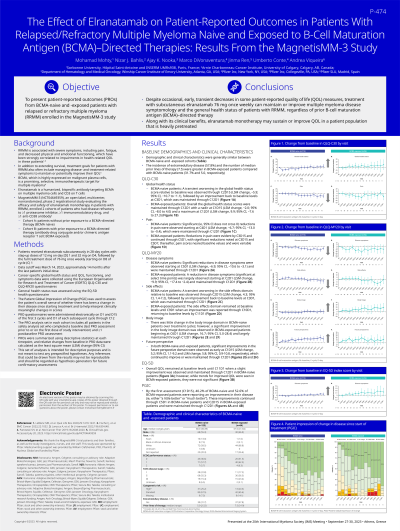QoL and Patient-Reported Outcome and Supportive Care
Poster Session 3
P-474: The Effect of Elranatamab on Patient-Reported Outcomes in Patients with Relapsed/Refractory Multiple Myeloma Naïve and Exposed to BCMA-Directed Therapies: Results from the MagnetisMM-3 Study
Friday, September 29, 2023
1:15 PM - 2:15 PM EEST


Mohamad Mohty, MD, PhD
Professor of Hematology
Sorbonne University, Saint-Antoine Hospital, AP-HP INSERM UMRs 938, Paris, France, United States
Introduction: Elranatamab is a humanized bispecific antibody that targets both B-cell maturation antigen (BCMA)-expressing multiple myeloma (MM) cells and CD3-expressing T cells. MagnetisMM-3 (NCT04649359) is an open-label, multicenter, non-randomized, phase 2 study to evaluate the safety and efficacy of elranatamab monotherapy in patients (pts) with relapsed/refractory MM (RRMM). Patient-reported outcomes (PROs) from this study are presented.
Methods: MagnetisMM-3 enrolled two cohorts of pts (Cohort A: BCMA-naïve; Cohort B: BCMA-exposed) who were refractory to at least 1 proteasome inhibitor, 1 immunomodulatory drug, and 1 anti-CD38 antibody. Pts received subcutaneous elranatamab 76 mg QW on a 28-day cycle with a 2-step-up priming dose regimen (12 mg and 32 mg) administered during the first week. PROs included the EORTC QLQ-C30, the EORTC MY20, and the EQ-5D generic quality of life (QoL) questionnaire. PROs were assessed on day (D) 1 and 15 of the first 3 cycles and D1 of each subsequent cycle (C) through C12, the last cycle included in this analysis. The data cut-off was January 12, 2023 (approximately 12 months after the last pt’s initial dose).
Results: 123 and 64 pts were enrolled and treated with elranatamab in Cohort A and B, respectively. Median age was 68.0 and 67.0 years, 55.3% and 46.9% were male, 58.5% and 68.8% were White. At baseline, 25.2% and 20.3% had high risk cytogenetics, 15.4% and 23.4% had R-ISS III, and 31.7% and 57.8% had extramedullary disease. The median number of prior treatment lines was 5.0 (range: 2-22) and 7.5 (3-19). Among pts in Cohort A, a transient worsening in the global health score (QLQ-C30) and side effects domain (MY20) relative to baseline was observed through C2D15 (least square mean [LSM] change=-5.9 [95%CI: -10.7, -1.1] and 4.3 [1.4, 7.2], respectively); both domains reverted to baseline levels by C3D1 and generally showed (non-significant) improvement from baseline starting at C7D1/C8D1. Significant reductions in pain (QLQ-C30) and disease symptoms (MY20) were observed starting at C4D1 (-6.7 [-13.0, -0.4]) and C5D1 (-6.9 [-10.6, -3.1], respectively) and were maintained. Overall QoL (EQ-5D) significantly improved by C11D1 (0.06 [0.02, 0.09]) and was maintained. Cohort B results were largely similar, though, due to small sample sizes, significant differences were less frequent. Only a modest (non-significant) worsening in the global health score was observed with the nadir at C1D15 (-2.0 [-8.0, 4.0]) followed by a (non-significant) improvement relative to baseline by C2D15 (5.2 [-2.6, 13.0]) which was maintained. A reduction (significant at select time points) of pain and disease symptoms was largely observed starting at C2D1 (-5.1 [-13.0, 2.8] and -9.9 [-17.4, -2.4]) and maintained.
Conclusions: Despite occasional early transient decreases, the results suggest that subcutaneous 76 mg QW elranatamab can improve the symptom and overall QOL of pts with RRMM, regardless of prior BCMA-targeted treatment.
Methods: MagnetisMM-3 enrolled two cohorts of pts (Cohort A: BCMA-naïve; Cohort B: BCMA-exposed) who were refractory to at least 1 proteasome inhibitor, 1 immunomodulatory drug, and 1 anti-CD38 antibody. Pts received subcutaneous elranatamab 76 mg QW on a 28-day cycle with a 2-step-up priming dose regimen (12 mg and 32 mg) administered during the first week. PROs included the EORTC QLQ-C30, the EORTC MY20, and the EQ-5D generic quality of life (QoL) questionnaire. PROs were assessed on day (D) 1 and 15 of the first 3 cycles and D1 of each subsequent cycle (C) through C12, the last cycle included in this analysis. The data cut-off was January 12, 2023 (approximately 12 months after the last pt’s initial dose).
Results: 123 and 64 pts were enrolled and treated with elranatamab in Cohort A and B, respectively. Median age was 68.0 and 67.0 years, 55.3% and 46.9% were male, 58.5% and 68.8% were White. At baseline, 25.2% and 20.3% had high risk cytogenetics, 15.4% and 23.4% had R-ISS III, and 31.7% and 57.8% had extramedullary disease. The median number of prior treatment lines was 5.0 (range: 2-22) and 7.5 (3-19). Among pts in Cohort A, a transient worsening in the global health score (QLQ-C30) and side effects domain (MY20) relative to baseline was observed through C2D15 (least square mean [LSM] change=-5.9 [95%CI: -10.7, -1.1] and 4.3 [1.4, 7.2], respectively); both domains reverted to baseline levels by C3D1 and generally showed (non-significant) improvement from baseline starting at C7D1/C8D1. Significant reductions in pain (QLQ-C30) and disease symptoms (MY20) were observed starting at C4D1 (-6.7 [-13.0, -0.4]) and C5D1 (-6.9 [-10.6, -3.1], respectively) and were maintained. Overall QoL (EQ-5D) significantly improved by C11D1 (0.06 [0.02, 0.09]) and was maintained. Cohort B results were largely similar, though, due to small sample sizes, significant differences were less frequent. Only a modest (non-significant) worsening in the global health score was observed with the nadir at C1D15 (-2.0 [-8.0, 4.0]) followed by a (non-significant) improvement relative to baseline by C2D15 (5.2 [-2.6, 13.0]) which was maintained. A reduction (significant at select time points) of pain and disease symptoms was largely observed starting at C2D1 (-5.1 [-13.0, 2.8] and -9.9 [-17.4, -2.4]) and maintained.
Conclusions: Despite occasional early transient decreases, the results suggest that subcutaneous 76 mg QW elranatamab can improve the symptom and overall QOL of pts with RRMM, regardless of prior BCMA-targeted treatment.
